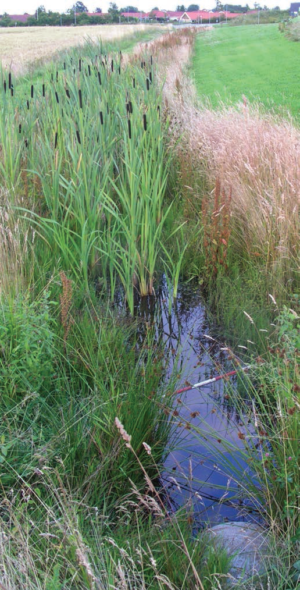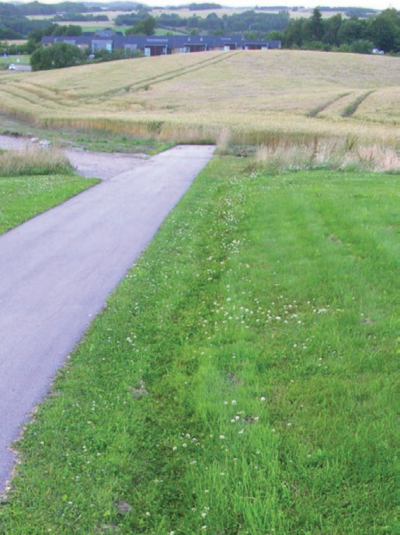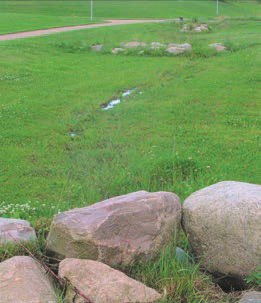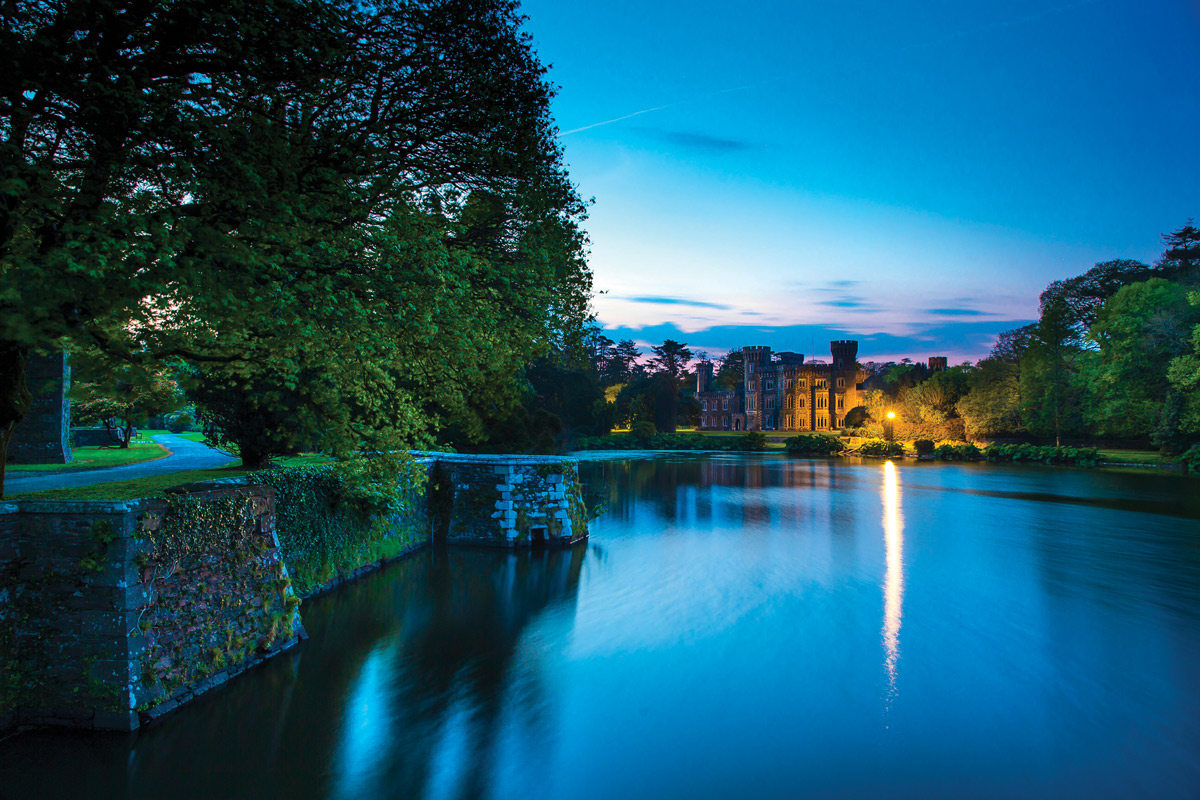Feidhlim Harty explains why we need to see greater use of swales in the Irish landscape
DESIGN CONSIDERATIONS
Swales are best designed at the earliest stage of a project, along with other site features such as building and access roads; otherwise, the available space quickly becomes cluttered with other features and surface drainage will be pushed underground as a space-saving measure. Another reason to include swales early in the design process is to make the best use of the natural site topography, ideally informing the positioning of houses and the open drainage network.
Base widths are typically 0.5m but can vary depending on the pollution status of the runoff water and the site size and topography. Swale edges typically have a slope of 1:3, but this can be steeper where space is limited, or shallower where the edge is part of the filter system for a yard or road contributing to the swale. Longitudinal gradients are typically no greater than 1:25 unless check dams are added, in which case the gradient can increase to 1:10 without leading to excessive flow velocities.
If you are designing with a specific SUDS objective as part of planning permission, then the overall storage volume is an important consideration. The CIRIA SUDS Manual[1] provides clear design guidance in this instance. However if the swales are simply part of a more ecologically sound and wildlife-friendly drainage network, then the exact volume isn’t particularly crucial. In this latter instance, it’s still important to ensure that the swale capacity is sufficient to convey surface water away from houses and roads, towards lower areas where periodic flooding is acceptable or even desirable. Ideally, the channel should be about twice the cross-sectional area of the equivalent stormwater pipe. In this way, plant growth within the channel won’t lead to unacceptable congestion, and will instead act as a part of the overall filtration process.
Swales are potentially low-cost, low-tech, eco-friendly filter systems, but they have their limitations. They are best used to serve relatively small catchments. For anything much larger than, say, a housing estate, they become rivers after a rainfall event and simply aren’t sufficient alone to filter the volumes of water passing through them. They can still be used to serve the initial stages of a series of SUDS components, but more suitable options may include infiltration basins, ponds or wetlands as the catchment size grows.
Given that swales take up a lot of space compared to piped stormwater sewers, they are generally unsuitable in dense urban settings. Although not always the case, they are generally best used for new-build projects rather than retrofitted into existing developments.
They also have open water during and after rainfall and thus pose a potential drowning hazard, like all open water features. This can be ameliorated by judicious planting with tall emergent species such as Phragmites, Iris and Typha in the base of wet swales or by fencing. A split chestnut paling will have a much lower carbon footprint than a tall metal fence, and look much more natural too.
Swales may not be the ideal option where extensive tree cover is desired. Excessive shading will reduce grass and wildflower growth, and thus reduce the capacity for attenuation and filtration of runoff. However, planting trees to the north side of a swale can allow both tree cover and good growth of plants within the channel base. Alternatively, for wet swales Luzula sylvatica and Carex pendula may be used as the main wetland species, thus permitting good growth even with limited sunlight.
A point in favour of trees is that they have an excellent capacity to improve infiltration into the soil, so judicious planting in a seasonally flooded bioretention area can be used as part of the overall design to help with water storage and groundwater recharge; particularly on sites with relatively poor drainage.
CONSTRUCTION AND PLANTING
If the swale design has been steered by site topography, then there may be minimal excavation required. Remove the topsoil over c.2-3m of channel width, to a depth of c.0.3m below the surrounding ground level. The base of the swale should be c.0.5m wide with gently sloping sides. Check dams of stone or compacted earth can be added at intervals if needed. Allow a slight drop on the swale side of any road drains, to minimise the potential for clogging with plants and silt.
The base and sides of dry swales can be seeded with grass or a wildflower mix. Lawn turf may also be used where the swale will be put into immediate use, but it is less costly to simply rake and seed the area at the appropriate time of year. Wildflower seeding may be carried out in the autumn, for spring germination, but repeat in the spring if winter rain has washed the area through.
The base of wet swales can be planted with mature bare-rooted wetland species such as Phragmites australis, Typha latifolia, Sparganium erectum, Mentha aquatica, Veronica beccabunga or other similar natives. It is often beneficial to add some mud from a nearby watercourse to introduce seeds and aquatic fauna at an early stage. This is particularly useful where earthen dams are used at intervals to create permanent or semi-permanent pools in which water beetles and other insects can thrive.
ONGOING MAINTENANCEUnlike with piped systems, issues will become apparent sooner rather than later. Maintenance typically includes cutting the grass in dry swales to a set design height, but I prefer to include a mix of wildflowers, or to include clover in with the grass seed to feed pollinators, so leaving this grow long has advantages for wildlife. A single cut of hay in September will keep briars in check and encourage new fresh growth of grass in the spring. Cut to a height of not less than 100mm to ensure that there is sufficient ground cover during the wet winter months for water filtration. Grass cutting in wet swales isn’t necessary, but the drier parts may benefit from an annual cut of hay. Bringing heavy mowing machines into the moist ground is neither easy nor necessary. Wetter areas can simply be let grow as they wish. Typha and Iris will have attractive foliage over the winter and provide cover for wildlife at a time when the cover is scarce. Any pipes under roads or to existing land drains should be checked regularly and cleared of accumulated leaf litter, twigs or other debris if needed. Designing a slightly deeper area close to outlets to help keep piped exits clearer of tall vegetation; or alternatively, have an area of dry shallower ground that can be mown annually. Litter should be picked up from the swales as it appears. Otherwise, the area can look ramshackle and unkempt and attract more litter. TO CLOSEFinally, remember that this isn’t rocket science. Water will follow its own way downhill. If you can simply encourage it in a way that offers habitat, filtration and sufficient containment to avoid causing a nuisance or hazard, then you’ll be contributing to the rewilding of our landscapes and waterways. There are lots of ways to avoid plastic and concrete, reduce your carbon footprint and help wildlife thrive rather than hinder it. Open drainage is just one of many solutions, and well worth incorporating into your next design project. |
SUDS COMPONENTS USED FOR STORMWATER CONTROL AND/OR FILTRATION. FOR CLEAN SITES SUCH AS RESIDENTIAL AREAS, A SINGLE COMPONENT MAY BE APPROPRIATE; FOR MORE CONTAMINATED SITES MORE COMPONENTS IN SERIES ARE NEEDED TO ENSURE THAT THE RECEIVING CATCHMENT IS PROTECTED.● Source control techniques such as green roofs, soakaways, water butts, rainwater harvesting systems. ● Pre-treatment systems such as oil interceptors and sediment traps. ● Filter strips – wide grassed or thickly planted buffer zones adjacent to impervious surfaces for the treatment of runoff water. ● Filter trenches and infiltration trenches – gravel-filled trenches that treat runoff water from path edges or paved areas. ● Swales – wide grassed channels that permit infiltration as well as transporting runoff water and/or providing storage. ● Bioretention areas – shallow planted areas that temporarily store stormwater runoff and allow it to percolate into the ground. ● Pervious paving – allows water to flow into a gravel substrate beneath the paved surface where it is stored for percolation, reuse or for filtration through the substrate to the receiving water or the next stage of the SUDS. ● Geocellular systems – performed plastic media which can be used to store runoff water below ground beneath paved areas. ● Sand filters – used where elevated pollution loads are anticipated, or were receiving water sensitivity is high. ● Detention basins – designed for water quality improvement as well as storage of runoff in storm events. They are typically dry basins, but built to facilitate flooding to a considerable depth as needed for storage purposes, then releasing water to the receiving environment or the next stage of the SUDS system. ● Infiltration basins – function in a similar manner to detention basins, but are designed specifically to facilitate infiltration of all flows into the ground. ● Ponds – a popular SUDS component, designed to maintain a sufficient depth of water, as well as providing runoff water storage and filtration. ● Stormwater wetlands – relatively shallow wetland areas that are designed to both store and filter the water volume generated during a storm event. |
SWALES IN PERMACULTURE DESIGN
In the Irish context, we rarely seek to hold onto the water that falls from the skies. That said, recent years have clearly shown that our farms can suffer from climate breakdown, through both flooding and droughts. There is a solid case to be made for permaculture swales, contour hedgerow and woodland planting, composting to increase soil humus and a myriad of other conservation agriculture measures to improve our management of water in the landscape and impact this has on the resilience of Irish farming. ✽ |
 FÉIDHLIM HARTY is an environmental consultant, director of FH Wetland Systems and author of two books on natural sewage treatment systems. His new book, Towards Zero Waste, was published this autumn. See www.wetlandsystems.ie for details. FÉIDHLIM HARTY is an environmental consultant, director of FH Wetland Systems and author of two books on natural sewage treatment systems. His new book, Towards Zero Waste, was published this autumn. See www.wetlandsystems.ie for details. |
REFERENCES
[1] WOODS-BALLARD B, KELLAGHER R, MARTIN P, JEFFRIES C, BRAY R, SHAFFER P (2007) THE SUDS MANUAL. CIRIA, LONDON.







